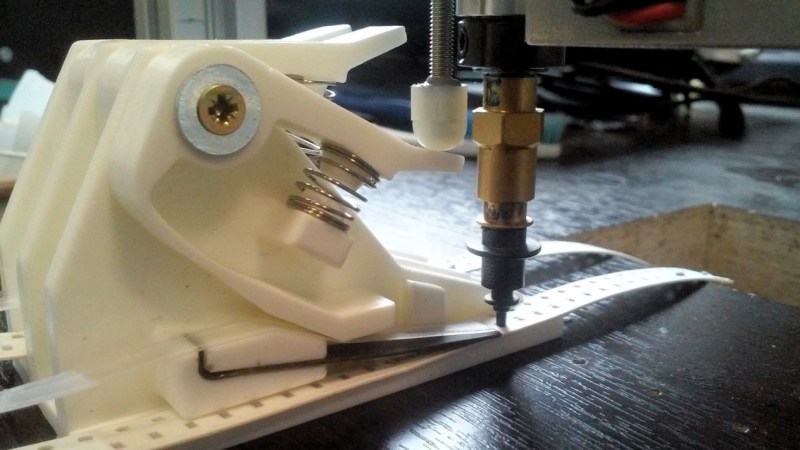It goes without saying that we love to see all the clever ways people have come up with to populate their printed circuit boards, especially the automated solutions. The idea of manually picking and placing nearly-microscopic components is reason enough to add a pick and place to the shop, but that usually leaves the problem of feeding components to the imagination of the user. And this mass-production-ready passive component feeder is a great example of that kind of imagination.
Almost every design we’ve seen for homebrew PnP component feeders have one of two things in common: they’re 3D-printed, or they’re somewhat complex. Not that those are bad things, but they do raise issues. Printing enough feeders for even a moderately large project would take forever, and the more motors and sensors a feeder has, the greater the chance of a breakdown. [dining-philosopher] solved both these problems with a simple design using only two parts, which can be resin cast. A lever arm is depressed by a plunger that’s attached to the LitePlacer tool, offset just enough so that the suction cup is lined up with the component location on the tape. A pawl in the lower arm moves forward when the tool leaves after picking up the part, engaging with the tape sprocket holes and advancing to the next component.
[dining-philosopher] didn’t attack the cover film peeling problem in his version, choosing to peel it off manually and use a weight to keep it taut and expose the next component. But in a nice example of collaboration, [Jed Smith] added an automatic film peeler to the original design. It complicates things a bit, but the peeler is powered by the advancing tape, so it’s probably worth it.















Very clever!
dining-philosopher’s design is probably the first of the recent development of printable, head-actuated feeders but there has been many clever design based on that. The best one I know is this: https://makr.zone/new-all-3d-printed-tapereel-feeder/399/
Thank you this one is amazing !
I really like the design, but it was lacking a good method to remove the cover tape. There are some variants that are doing this, see:
https://makr.zone/new-all-3d-printed-tapereel-feeder/399/
https://loonatec.com/pnp-semi-automatic-feeder/
In this design tape may slip, and it will be fed problem. why not just print simple gear what drive tape by holes on the tape and use same push in drive
Indexing is overkill, just look where the next component is (with a camera that most pick-and-place systems need anyway) If the next component is not anywhere near the expected location, press the lever again, to account for slippage, etc. That could even handle various component and index sizes: for very small component press the lever only occasionally to get multiple new components in view, and for very large components press it 3x for each component.
Or one can do like some cheap Chinese pick and place machines do.
They have a solenoid actuated pin on the pick and place head, that it pokes into the hole on the tape, and drags it along a set distance.
So the component strip itself is just held in place by a guide, a spring clip, and two pieces of metal on top.
The tape is pulled back by a single motor driven rod with multiple spools on it, each spool is generally free to just slide, but has a fairly simple clamping mechanism providing adequate tension for it to pull back the tape, but not enough tension to also drag out more components. (The tension is set by a setscrew pushing a piece of plastic against the rod, the more it pushes, the more friction one gets.)
A CHMT48VB machine is a machine using this setup.
In my own experience running such a machine, it works great about 99.5% of the time.
Though, a lot of the problems with the setup can be fixed by having a camera and a bit of image processing software. (To locate the holes on the strip, and see if there is a component on the strip for it to pick, or sense if there is a proper vacuum near the nozzle.)
The main problem I have had with these cheap chinese machines is that they at times rotate to23 packages 45 degrees due to misinterpreting the feet. (the detection for it is super simple, it lights up the bottom of the component with a ring light, this makes all legs a bright white/gray, while everything else in the picture is mostly black/dark. Then it puts a square that is as close to the bright pixels as possible. Though, it doesn’t rotate the square to get a better fit, nor seem to care about the component type at all… Then the center of the square is the center of the component. This doesn’t work all that reliably for some component types…)
How does a camera sense if there is a proper vacuum?
Well, the statement does indeed imply that. Sorry.
But yes, we would use a pressure sensor.
(though we could have a gauge poking out into view. But an I2C sensor is likely easier to use.)
Awesome share thanks I also tried have a look https://www.youtube.com/watch?v=FrGPu49nKsw, please must comments and I want to add vision system to it, need help please (don’t mind my English) thanks…